
O Tuscan Salami is typical of Italy and is also known as finacchiona. Tuscan Italian Salami Finocchiona originates in the Middle Ages, between the 14th and 15th centuries. It is a salami that contains fennel, or finacchio in Italian, which is why it is also known as fenocchiona. It is a salami that is generally thick and has medium or long maturation. Fennel was initially used to replace black pepper, which was a much more expensive ingredient. The product became popular and is now produced in several regions of Italy.
The salami Finocchiona It was registered, in 2015, as a product of controlled origin and can only have this name when produced in the Tuscany region.
There is a variation of this salami called sbriciolone, which consists of the same recipe with shorter maturation and thicker pieces of meat. I also made this variation by cutting half of the meat with a knife. I took this opportunity to test whether there is a significant difference in the final texture of the salami comparing meat ground in a machine and cut by hand. In general, home grinders partially crush the meat, reducing the quality of the final product, so I'll see if this is noticeable in this test.
INGREDIENTS
- Purchased shank – 3040g;
- Clean shank – 2120g;
- Salt – 40g;
- Type 2 Curing Salt* (6% of nitrite, 3% of nitrate and 93.75% of salt) – 5g;
- Garlic – 10g;
- Sugar – 8g;
- yakult (fermented milk) – 1 small pot (or starter culture, if there is);
- Red wine – 50ml;
- Black pepper – 8g;
- extra fat – 100g; – optional
- fennel seed – 14g;
- Beef tripe** medium size – 4 segments of 30cm.
*If you have questions about curing salt – sodium nitrite and sodium nitrate – read the post Curing salt what it is and how much to use
**Beef casing can be replaced with high caliber pork casing or 45+ caliber collagen casing. Buy already cut or cut the tripe into 30 cm segments and tie one end with string. This will make filling easier.
Preparation of Tuscan Italian Salami
Refrigerate leaving the meat very cold, remove from the refrigerator, remove the skin (leather) preserving as much of the subcutaneous fat as possible, as it can be used in salami. Chop the fat into small pieces, the desired size for the final product, set aside and freeze. I prefer thicker pieces of fat as some people prefer to remove it, so larger pieces make it easier to remove.
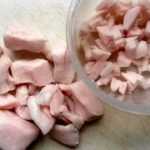
Clean the meat well, removing as much connective tissue as possible. Cut into cubes of approximately 1 cm.
To extract the aroma, grind the fennel seeds with a blender or pulse quickly in a blender.
Add all the ingredients to the meat except the yakult and fat, which will be added at the end of the preparation just before embedding. Mix enough so that everything is evenly distributed and refrigerate for 24 hours. During this period, the salt and curing salt will be incorporated equally.
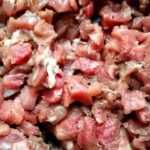
Remove from the refrigerator and pass all the meat through the grinder or, if you prefer or don't have a grinder, chop with a very sharp knife into very small pieces, as small as you can.
Add the Yakult and frozen chopped fat. Mix well with your hands or beat in an orbital mixer with the flat paddle for approximately 2 minutes. The mixture should be well combined and sticky, this will make the salami more compact.


Proceed with filling the dough into the casings. Leave it very full, that is, apply pressure and add a lot of dough, leaving it very compact. Make holes where there are air bubbles and tie the other end of the casing.

As you can see, the amount of meat in the recipe yielded four salami. Their initial weight was between 553 and 686 grams.
To promote the initial fermentation of the lactic acid bacteria in the yakult, I left it hanging at room temperature for 24 hours. It was cold so it didn't go over 20 degrees. After 24 hours I hung it in the cellar to finish curing. The cellar has temperature control and fan-forced ventilation, so it works very well as a curing chamber.
Initially I set the temperature at 17 degrees and left it for 6 days, then I reduced it to 14 degrees and kept it that way until the end. Humidity was between 75% and 70% throughout the period. In theory it is low humidity, but I had no problems. I added a glass of water and salt to the bottom of the chamber to help maintain this humidity. The more glasses of water you add, the more humid the enclosed space will be. It can maintain up to 85% of humidity, the wetter the slower the process, but, in theory, the better the final product will be.
Findings
There were 22 days of curing in the chamber;
The total weight loss of salami was between 44.79% and 47.20%;
Daily weight loss ranged between 2% and 3%, varying very little from one salami to another and with no difference between ground meat and meat cut with a knife;
Fermentation was strong and even its smell was quite striking throughout the curing process. Yakult is great for making salami!
The salami was completely colonized by the smooth, dry white colony, an excellent indicator that everything was going well. Once again I conclude that yakult is great for making salami!
There was a subtle visual difference between the ground meat and the meat chopped with a knife.
The texture of the salami with ground beef and cut with a knife was significant in terms of softness, the salami with ground beef was softer compared to the chopped one. I particularly preferred the ground one.
And most importantly, the flavor was excellent, striking, slightly spicy and acidic (I believe due to the wine and fermentation), it fills your mouth with saliva when you eat it. I noticed the sweet herb. A delight! I recommend everyone to do this, anyone who has only eaten commercial salami from large refrigerators will notice a huge difference in the flavor.

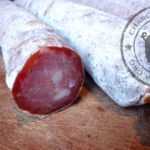


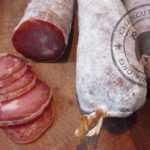
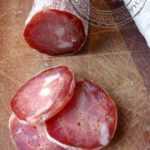
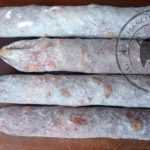
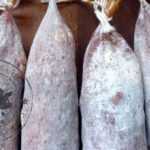
-
 Curing salt 1R$ 8,00
Curing salt 1R$ 8,00 -
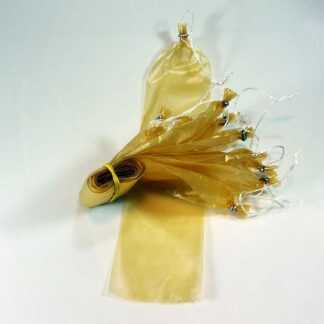 Salami collagen casing 45mm 10 units tiedR$ 22,00
Salami collagen casing 45mm 10 units tiedR$ 22,00 -
 Collagen casing 80mm cup and salamiR$ 29,90
Collagen casing 80mm cup and salamiR$ 29,90 -
 Natural pork casing for sausageR$ 52,00
Natural pork casing for sausageR$ 52,00 -
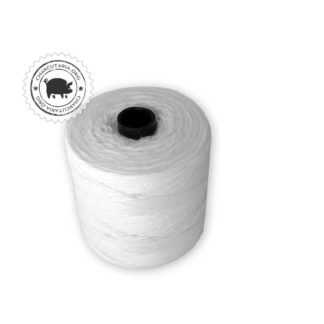 Polyester culinary twineR$ 16,00
Polyester culinary twineR$ 16,00 -
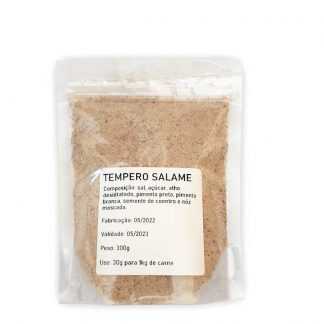 Salami seasoningR$ 20,00
Salami seasoningR$ 20,00 -
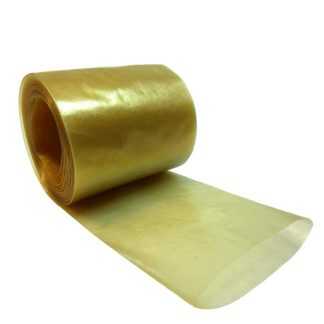 Salami collagen casing 50mm roll 5 metersR$ 29,00
Salami collagen casing 50mm roll 5 metersR$ 29,00 -
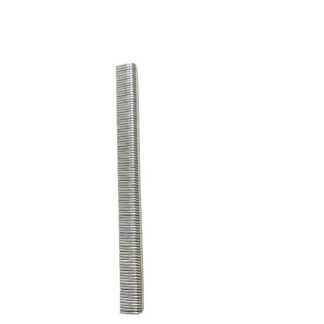 Aluminum clampsR$ 6,00
Aluminum clampsR$ 6,00 -
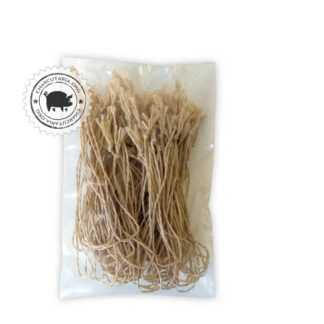 Built-in hanging loopsR$ 15,00
Built-in hanging loopsR$ 15,00 -
 S632 aluminum clampsR$ 30,00
S632 aluminum clampsR$ 30,00 -
 Professional manual staplerR$ 2.680,00
Professional manual staplerR$ 2.680,00

Hello, Edu! How are you? Friend, I'm just starting out and I have a question about maturing salami in the fridge (using that bowl + fan + hygrometer). The question is: when my wife opens the refrigerator, will she smell a strong smell coming from the ripening salami? hahaha Is the refrigerator permeated with a smell? It stays, right? But is the smell good or is it acidic/bad? Hugs!
The strongest smell is that of the condiments. Aging also brings a smell, but if the quantity of salami is small, like 3 or 4 salami, the smell will be mild. If you make fermented salami, the smell is more acidic, if you make it without fermentation, embedding it and putting it in the fridge, the smell is more neutral.
Good afternoon
I really liked everything. I found everything very well explained.
I will place an order at the end of the month. Products for
make salami and cups.
Good afternoon, can you make this recipe in the fridge following your step-by-step instructions? In this case, just let it ferment for a day outside the fridge and then cure it inside the fridge with the box and fan?
One more question, adding Yakult with wine and sugar, doesn't it make the salami too acidic?
Thank you for your attention.
Hi Almir. You can do it that way in the box in the fridge, it will work. Acidity due to fermentation is regulated by the amount of sugar, so by adding little sugar, lactic acid bacteria will have little source to acidify. The recipe has little sugar, so it's not too acidic. The wine is optional, a complement to protect while fermentation has not yet occurred sufficiently.
Eduardo, I made two recipes, one using fennel and the other not. To embed I used natural beef casing… I felt that in salami without fennel there was a transfer of flavor and aroma from the casing to the salami… how can I avoid this? A photo of the result.
Can Finocchiona Tuscan Italian Salami be lightly smoked?
Grateful
Yes, you can, but smoke at a low temperature to avoid cooking the meat.
This salami has the same proportion of sugar and salt… from what I saw the others have 1/2 portion of sugar in relation to salt…. Could you comment on this particularity for us?!?!
I bought some products in your store and they arrived yesterday... today I prepared my first salami following this recipe... as soon as it's ready I'll post the result here.
Hi Julio, the amount of sugar will generally vary according to the starter culture, which feeds on sugar to produce its effect, the more sugar the more bacterial activity. In this recipe, the yakult culture was used as a test, and there is no indication of the amount of sugar. To ensure fermentation, I chose to add more sugar than conventional. The starter culture for use in meats that we sell recommends the addition of 0.5% of some source of sugar. If you made it following this recipe that has more sugar than recommended by the starter culture, no problem, it won't be a general problem, it will just intensify the fermentation, making the salami a little more acidic.
If you are not going to use a starter culture, then the rule is not to ferment the salami and not to add sugar, this way you avoid the proliferation of unknown microorganisms.
Thank you very much for the explanations…. Just to be clear, fermentation takes place within 24 hours at room temperature after embedding, correct?!?! Today it's been a week since I did it for the first time... follow the photo... this white mold is appearing, do I remove it or keep it?!?! Criticisms and comments are welcome.
Fermentation must be carried out whenever a starter culture is used, immediately after embedding, at room temperature (ideally 25ºC) for up to 72 hours. After this period, transfer to a refrigerated environment (ideally 12ºC). Molds should always be removed if you have not applied mold-type culture (fungal/mold).
Thanks for the explanations… Today it’s been a week since I made the salami from this recipe…. they are in a cellar at 18 degrees with a pot with 400 ml of water/salt… a lot of white mold has appeared, do I remove it or keep it?!?! Critical questions are welcome.
Hi Julio, if you have not applied the fungal culture (penicillium mold) the ideal is to always remove any spots of mold that appear. Scrub with water, salt and vinegar.
Thank you for the informations. I removed the mold with water, vinegar and salt…. I removed the pot of water from the cellar and lowered the temperature to 14 degrees... unfortunately I didn't buy the start culture, as I followed the recipe and used the yakult... Is it worth spraying the Yakult itself on the salami?!?!?
Julio, if you have already added the yakult to the salami dough then it is unnecessary to sprinkle it on the outside.
Eduardo, I made two recipes, one using fennel and the other. To embed I used natural beef casing… I felt that in the salami without fennel there was a transfer of flavor and aroma from the casing to the salami… how can I avoid this?
Hi Julio, beef tripe has more odor and is more susceptible to microorganisms. What they generally do is give the intestines a vinegar bath to reduce the smell and protect against acidification. Another option is collagen casing, which tends to be a great alternative to salami.
Hi Edu, look here again….
Next today I cut a salami, I made this recipe with yakut. Edu and the next person had never made salami but I think something went wrong… the salami had air inside it and when it was cut, a clear liquid came out…. Why this liquid? Is it bad to consume? I ate a few slices with the tobas in my hand. Can you explain to me why Edu? I bought 1 salami at the market and its smell is much stronger and it is also still dripping with fat if left outside the Chamber.
Note: they are producing white mold and I had spoken to you and you told me to clean with salt water.
Hi Fabio, the internal air may have gone with the dough when embedding. The ideal is to compact the dough well before filling it to remove the air that is trapped in the middle. Another possibility is contamination that produced carbon dioxide and created the bubbles. Were you able to keep the salami at a low temperature during the maturation process? Does the liquid look like fat or something else? What is the average ambient temperature? If you can, send photos.
If very white and fine mold (like powder) forms, you can keep it or remove it, it's optional. Any other mold is always recommended to be removed as soon as possible by scrubbing it with brine.
I think it was air when it was embedded. The salami was kept at a low temperature of 12 to 14c.
The problem is this thick liquid, the salami tasted like lemon (I think it's acidic).
I will send photos... They are free of white mold, they are clean.
Yesterday I wrapped them in baking paper, the camera is 80% damp, I think they are getting hard.
I only opened 1 salami the others are closed
Was it on parchment paper from the beginning or just now that it was wrapped? Because inside the chamber with a humidifier, it should not be on parchment paper. Paper is just a workaround for when the environment is very dry.
Hello, is the garlic you used natural? Or should it be garlic powder?
Hi Nicolaz, in this case it was fresh garlic, but you can use garlic powder, however you prefer.
Can I smoke salami? What's the procedure? Is it done before or after healing?
Hi Andriel, yes you can smoke salami. Smoke the log after embedding or after fermenting (if using starter culture) for 4 to 8 hours at a low temperature, up to 40ºC, to avoid cooking the meat. Then hang to cure/dry/mature until you lose the desired weight. Hugs!
Goodnight!
In other salami recipes, can I replace the starter culture with yakult?
Att.
Julian
Hi Juliano, yes you can replace it. It's always good to remember that yakult is a lactic acid bacterial culture that has not been tested for this purpose, so it apparently works for the acidification issue, but the process is not fully known.
Hello Eduardo. This time I should make the fenocchiona salami but I have some doubts. On some Italian websites, I saw that they use much larger calibers, even larger than those used in mortadella. Did you check out the reason for this difference? Does anything change the final result of the product? I also noticed that the fat is chopped into smaller cubes than those presented by Brazilians. Regarding the flavor specifically, does it make any difference for this reason?
Finally, I must strictly follow the recipe you published, but some people question the use of yakult, saying they made both recipes (with and without) and it doesn't add anything to the result. I personally don't believe it doesn't do anything but I would also like to hear your opinion on this.
Lastly, what caliber do you suggest?
abs.
Hi Fernando. Caliber is an option that will alter the final product due to the time it will take to lose weight. The larger the caliber, the longer it will take for the internal water to migrate out, consequently the longer it will take for the salami to be ready. The longer it takes, the more matured the salami will be. The more mature it is, the more elaborate the flavor will be. The larger the caliber, the more important it is to maintain an environment with the correct conditions (temperature and humidity). Thinner salamis dry faster and there is less risk of problems. If you want to make a more elaborate product, I recommend using starter culture suitable for meat. Yakult is a lactic acid bacteria that has not been tested in meat. It will acidify and protect, but there is no proof of any other function that improves the flavor, aroma and texture of the salami. Purchase a culture that has multiple actions (protection through acidification, flavor and aroma). If you are interested, do some research and also take a look at what we sell. https://charcutaria.org/categoria-produto/culturas-starter/ The thickness of the fat is more a question of the recipe, regional culture or individual taste. You can follow the path that suits you best. I recommend low calibers, between 45 and 50. High calibers are recommended for those who already have… Read more "
Thank you for your attention. I already bought all the ingredients from you, including the Starter. Regarding it, I saw in a recipe that all the ingredients and condiments are added with the exception of the starter, which should only be added after resting for 12 hours in the refrigerator. Does it proceed?
Hi Fernando. You can add the starter culture to the dough mixture, along with the other seasonings. You can apply it later too, but ideally it is done directly when mixing the dough.
I have a question, my cellar is not very big, the salami keeps touching each other, is there a problem or is it normal, can I leave it? In this case, from time to time I change places, so as not to remain in the same position.
Claudenir, no problem, do what you suggested and alternate frequently so as not to leave an area without exposure to air for a long time. Hugs!
Good evening, I made the Italian salami like this in the recipe, I put them in the cellar, I used the hygrometer, with the right temperature and humidity, but it didn't have a very pink color like the salami you made, what should I do .
Thanks.
Romero Batista Marinho
Hi Romero, how much did you add the curing salt? Do you know the composition of curing salt?
Eduardo, I use Exato's curing salt 2, which is indicated on the packaging to use 300g for 100kg of meat, that is, 3g per kilo of meat, but I hadn't noticed that it was expired, maybe that's what didn't work. a good color on the salami, but it was very tasty. Can you recommend another brand or will I continue using the same one. I've already taken four smoked courses and this curing salt was always used, with it I also prepare the dry cure. But I didn't take any course on salami, I do it with utmost confidence, bacon, ribs, sirloin cup, Calabrese sausage, smoked loin and tenderloin. For the loin, loin and tenderloin I use Aglomax for Ham.
Thanks.
Romero
Hi Romero. An indication that the curing salt is no longer working is the absence of the reddish color fixation. I use the Bremil B002 curing salt for salami. I also use it after the expiration date, but I always pay attention to how the color lasts. It usually lasts 1 year, after that it starts to reduce the effect of the additive, then I throw it away. Another thing you can do is use a sodium erythorbate-based antioxidant together. I use the antioxidant/fixer B1699 also from Bremil, it enhances the healing action and, in addition to preventing rancidity, it also has the function of a healing accelerator/cure fixer. Hugs!
Thank you Eduardo, congratulations on your posts. Hug !!!!
Goodnight. Does the anti-oxidant replace sugar? How much should I use in your recipe? What I have acquired from yourselves.
Hi Fernando. The antioxidant does not replace sugar, use it together. Use in the same proportion as the curing salt. For example, if you used 2.4g of curing salt per kg of salami dough, use 2.4g of the antioxidant. Hugs!
Good morning dear Eduardo! I would like to ask a question; I made a salami faithfully following a very simple recipe. After being bagged and punctured to remove all air bubbles, I hung it in an airy place for 48 hours and then rolled it 2 and a half times in baking paper and placed it in the fridge on a rack without touching anything. I noticed that on the 3rd day it smelled strong, but after the 15th day I removed the baking paper and the salami was very moist and the smell was still strong, and in the middle it was very soft and at the edges it was firmer. I washed the salamis with vinegar and dried them, placing them on baking paper again. I also noticed after 22 days that they are very soft in the middle, looking like I made them 3 days ago, and at the ends they are firmer and the smell is already milder. Today, after 38 days, the smell has improved a lot, very soft and some of them still remain very soft in the middle and the others are firmer throughout. Regarding weight, everyone is gradually losing weight. What is happening, is this normal? Thank you for your attention to everyone and me and congratulations on… Read more "
Hi Arilton. This is very common with the use of parchment paper and refrigerators. The refrigerator is very dry and the baking paper tries to create an extra barrier to avoid rapid drying, but the baking paper was not designed for this, it is a “workaround” that alleviates the problem (not always). What happened is that the outside of the salami dried very quickly (because the fridge is dry) and prevented the crumb from losing moisture, which is why the outside became more rigid and the inside very moist/soft. The result is very slow weight loss and the outside is much tougher than the middle of the salami. The correct option is to dry in an environment with relative humidity close to 80%. I'm testing a solution using the refrigerator that can solve this problem, it's in its final stages, I'll soon post a video showing the result, follow our YouTube channel and you'll receive the update. http://www.youtube.com/c/Charcutaria
Hi Eduardo, I've never made salami, and I'm thinking about starting the article, it will help me a lot, my question is as follows, with this curing, fermentation and maturation process I can eliminate any bacteria that may be in the pork, like worms and etc.
Rodolfo, fermentation serves to acidify and protect, as the low pH inhibits the proliferation of a wide range of pathogens. Fermentation can be replaced by the addition of an acidifier, such as wine or citric acid. The cure is the loss of moisture, which is also a progressive protective barrier. Maturation (natural enzymatic action of aged meat) is a process that only generates aroma and flavor. Curing salt is a preservative that also helps color and prevent rancidity. The most important protective barriers are common salt (sodium chloride), acidification and curing salt (nitrite and sodium nitrate). In delicatessen, what we need is to mitigate the chances of contamination, think about reducing the chances. If you work well on process hygiene and apply protective barriers, you will have a very safe product that is unlikely to suffer from contamination. Also read about the mold in salami at the link below. Hope this helps.
https://charcutaria.org/carnes/mofo-no-salame-e-em-outros-embutidos/
Thanks for the answer reply Eduardo…
My doubt is related to the pig bug, if the pig is contaminated and we eat its meat raw we can catch it.
From what I understand, this salami doesn't need to be smoked, so wouldn't the meat be raw?
Hi Rodolfo. When smoked, salami is subjected to a low temperature, close to 35ºC for a few hours, then cured equally, that is, the temperature is not used to eliminate existing contamination. There are cooked salami (salame cotto), but it is a totally different product. Using appropriate protection barriers and purchasing meat from good sources, certified, it is a completely safe product. Commercial Italian salami from slaughterhouses are all made this way, with raw meat, most of the time without smoking. From what I know, smoking is more common in German and colonial salami from the south of the country. Hugs!
Good morning Eduardo, Thank you very much for your answers, I will soon start producing my first salami.
Hi Eduardo, how are you?
Can this salami be smoked?
Yes, you can, at low temperature so as not to cook.
As you can see, I'm still very new to the subject but I've already ventured into this first venture and I may have confused some terms with maturation and fermentation or curing. thank you very much…
The important thing is that you have started, you will soon be more comfortable and confident. The first is always the hardest. If you have any questions, do not hesitate to ask!
My cellar is small and that's why the salami is pushed to the side. Will I have any problems with that?
I made it today and because it's a high temperature I've put it straight into the cellar and I'm keeping the temperature at 25G for fermentation. Is this going to work? Fermentation?
My cellar also cannot reach a temperature lower than 22G during the day, will I have problems with maturation? During the night between 00:00 and 06:00 in the morning it is 16.17 degrees.
Humidity I'm keeping at 85 % oscillating between 75 and 90% due to the time I've been away..
Thank you in advance for your attention..
And congratulations on the website and the agility in responding…however, I think it would be very satisfying to be able to help us…
Hi Thiago, regarding lying down, it's not ideal but it won't make the process unfeasible. Swap them around every now and then. Fermentation will work at 25ºC. The humidity is good. Fluctuating temperature is the biggest problem. I don't know if it's possible, but try moving the cellar to a colder and preferably dark environment. Keep an eye on it and, if any external contamination appears, use a cloth dampened with brine and vinegar to clean it.
Thanks again for your attention..so Eduardo, I have a small refrigerator and today I managed to buy a temperature selector, I'm going to install it on it and keep the temperature at 12 degrees..if it works I'll post photos with details, thank you very much..
Why is there salt in the water?
How does salt help with cellar humidification?
The salt only serves to protect the water from contamination. Does not interfere with the process.
Goodnight! Eduardo, enlighten me, was this fungal colony formed by Yakult? You also mentioned putting the salami in the refrigerator drawer, will the fungus form on the salami completely? Whenever I make some salami, I use the Di Carne product made for salami, it's good, what do you say?
Hi Celso, the yakult was to generate additional protection from acidification (lactic acid) due to the bacterial action of lactobacilli, the fungi proliferated quickly as the salami developed correctly and the fungal strain was already present in the environment in which I left it to dry. As I do frequently and have already applied a fungal culture, so the environment is already colonized. As for ready-made mixes, I've never used them, I prefer to make them from scratch so I can test the use of additives, amount of salt, processes and seasonings. But to make it easier, especially in quantity, the ready-made mix is very interesting.
Gos
Would you like to know if this salami can be aged in the refrigerator, wrapped in baking paper?
Say it now, thank you for your kindness.
Yes, it is possible, but there is a risk that the outside of the product will become more rigid and darker in color and the inside will become softer. In addition, the inside of the baking paper is much more prone to unwanted mold. If the correct environment is not possible, you can do it in the refrigerator but try to place the salami inside the fruit drawer or another closed compartment to increase the humidity a little. The important thing is to try to increase the humidity in the region as the refrigerator is very dry.
Dear Eduardo, but can you let it touch the parts of the drawer or not?
The ideal is not to touch it, but if this is not possible, you can turn it daily so that all sides lose moisture equally.
I would like to know more about the winery. What would be ideal? With temperature control and air circulator. Thanks.
Hi Gustavo, that's right, it has to have temperature control that keeps it at 14 degrees and a fan for air circulation. Ideally, it should be vertical so you can hang the products. The one I used is a Brastemp 12 bottles.
Curiosity: What is the role of powdered milk in this recipe?
Powdered milk serves as a stabilizer, providing less liquid loss and more stability to the dough ingredients.
Thank you very much for your support!
I'll end up getting good at this...
Hug
Hello Eduardo!
Will there be a problem if I use #1 curing salt instead of #2? In my city, I only found the #1 and it was still easy to buy in the quantity I needed.
For salami, the ideal is curing salt 2 for its prolonged action, but I've also tried curing salt 1 and it worked without any problems. To be sure, add a little more wine as acidification is one of the protective barriers against contamination, especially from the bacteria that cause botulism.
How to maintain closer contact as I intend to start this activity and I don't know a lot of things
Hi Giacomo, you can send as many questions as you want in the comments, even if I or other users try to help. But, if you prefer, you can send questions to contato@charcutaria.org. A big hug!
Congratulations on the site friend, one question, you informed that the caliber of the intestine that made this salami is medium. Would this average value be a 45mm casing? Thanks!
Hi Diego, I bought it from a trusted store here and asked for the medium size of beef intestine for salami, so I don't know exactly what size it is. It comes already cut and with one side tied. It should be around 45mm, yes, but if you want I can check the exact caliber and price. There was also collagen but I opted for the natural one because it “breathes” better. Hugs!
The use of Yakult is very interesting. I will use it in the next recipe.
Congratulations on the website.
In the case of salami, is it not necessary to use antioxidants?
Thanks
Hi Hernando, good question! Initially I see the antioxidant as optional. As it is a long-lived product, it will help preserve and prevent rancidity, but as a curing accelerator, reducing residual nitrite, I believe it is unnecessary, as the intention is for the sodium nitrite to exist slowly. I searched a little and found this study which deals with rosemary oil as a natural antioxidant in salami.
I adore! Keep emailing. Marcia.
I'm going to make this salami, it will be delicious.
I hope you approve. I really enjoyed it and will definitely do it again!